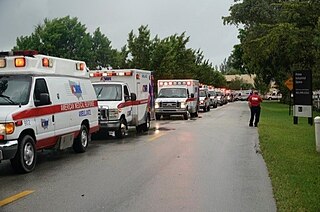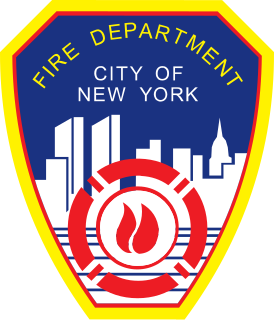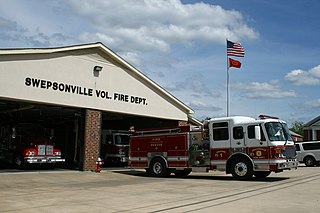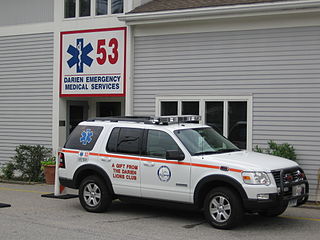
Emergency medical services (EMS), also known as ambulance services or paramedic services, are emergency services that provide urgent pre-hospital treatment and stabilisation for serious illness and injuries and transport to definitive care. They may also be known as a first aid squad, FAST squad, emergency squad, ambulance squad, ambulance corps, life squad or by other initialisms such as EMAS or EMARS.

The New York City Fire Department, officially the Fire Department of the City of New York (FDNY), is an American department of the government of New York City that provides fire protection, technical rescue services, primary response to biological, chemical, and radioactive hazards, and emergency medical services responses to the five boroughs of New York City.

A volunteer fire department (VFD) is a fire department consisting of volunteers who perform fire suppression and other related emergency services for a local jurisdiction. Volunteer and retained (on-call) firefighters are expected to be on call to respond to emergency calls for long periods of time, and are summoned to the fire station when their services are needed. They are also expected to attend other non-emergency duties as well.

The Chicago Fire Department (CFD) provides fire suppression, rescue services, Hazardous Materials Response services and emergency medical response services to the city of Chicago, Illinois, United States, under the jurisdiction of the Mayor of Chicago. The Chicago Fire Department is the third largest municipal fire department in the United States after the New York City Fire Department (FDNY) and Cal Fire. It is also one of the oldest major organized fire departments in the nation.
Firefighting jargon includes a diverse lexicon of both common and idiosyncratic terms. One problem that exists in trying to create a list such as this is that much of the terminology used by a particular department is specifically defined in their particular standing operating procedures, such that two departments may have completely different terms for the same thing. For example, depending on whom one asks, a safety team may be referred to as a standby, a RIT or RIG or RIC, or a FAST. Furthermore, a department may change a definition within its SOP, such that one year it may be RIT, and the next RIG or RIC.

A nontransporting EMS vehicle, also known as a fly-car, response vehicle, or fast response vehicle, is a vehicle that responds to and provides emergency medical services (EMS) without the ability to transport patients. For patients whose condition requires transport, an ambulance is necessary. In some cases they may fulfill other duties when not participating in EMS operations, such as policing or fire suppression.
In American law enforcement, the Emergency Service Unit, or ESU, is a multi-faceted element within a law enforcement agency’s Special Operations Command.
As firefighting has a rich history throughout the world, traditions in this profession vary widely from country to country.

The Montgomery County Fire and Rescue Service (MCFRS), officially the Montgomery County Department of Fire and Rescue Services (DFRS), is the public safety agency that provides fire protection and emergency medical services for Montgomery County, Maryland. The services are provided by a combination of paid county personnel and volunteer members of the various independent, non-profit volunteer fire and rescue corporations located throughout the county.

The Fullerton Fire Department is the agency that provides fire protection and emergency medical services for Fullerton, California. The department is responsible for an area of approximately 22 square miles (57 km2) that has a population of just over 135,000 as of 2010.

Fort Lauderdale Fire-Rescue Department is the fire and rescue service provider for the City of Fort Lauderdale, Florida, as well as the cities of Wilton Manors and Lazy Lake through service contracts. Additionally the FLFRD is responsible for ARFF at Fort Lauderdale Executive Airport. In 2013, the department responded to 44,387 calls for service.

In the United States, emergency medical services (EMS) provide out-of-hospital acute medical care and/or transport to definitive care for those in need. They are regulated at the most basic level by the National Highway Traffic Safety Administration, which sets the minimum standards that all states' EMS providers must meet, and regulated more strictly by individual state governments, which often require higher standards from the services they oversee.
Emergency Medical Service in Germany is a service of public pre-hospital emergency healthcare, including ambulance service, provided by individual German cities and counties. It is primarily financed by the German health insurance companies.

An emergency medical dispatcher is a professional telecommunicator, tasked with the gathering of information related to medical emergencies, the provision of assistance and instructions by voice, prior to the arrival of emergency medical services (EMS), and the dispatching and support of EMS resources responding to an emergency call. The term "emergency medical dispatcher" is also a certification level and a professional designation, certified through the Association of Public-Safety Communications Officials-International (APSCOI) and the International Academies of Emergency Dispatch. Many dispatchers, whether certified or not, will dispatch using a standard emergency medical dispatch protocol.
The Twin State Mutual Aid Fire Association is the dispatch center and coordinating agency for fire and emergency medical services operations in 23 towns in Grafton County, New Hampshire, and Orange County and Caledonia County in Vermont. Dispatching duties are handled by the Grafton County Sheriff's Department stationed in North Haverhill, New Hampshire.
The Dutchess County Department Of Emergency Response has the responsibility of governing Emergency operations in Dutchess County, New York. This encompasses Police, Fire and EMS.

The San Antonio Fire Department provides fire protection and emergency medical services for the city of San Antonio, Texas. The department is the third largest fire department in the state of Texas. With over 1,800 members, the SAFD is responsible for a population of over 1.4 million people apread across 408 square miles (1,060 km2).

Emergency Medical Service in Austria is a service of public pre-hospital emergency healthcare, including ambulance service, provided by individual Austrian municipalities, cities and counties. It is primarily financed by the Austrian health insurance companies.

The Baltimore City Fire Department (BCFD) provides fire protection and emergency medical services to the city of Baltimore, Maryland, United States. Founded in 1797 and established in 1859, the Baltimore City Fire Department covers an area of 81 square miles (210 km2) of land and 11 square miles (28 km2) of water, with a resident population of over 640,000 and a daytime population of over 1,000,000. The BCFD responds to approximately 235,000 emergency calls annually. There are two International Association of Fire Fighters (IAFF) locals; IAFF 734 for firefighters and IAFF 964 for officers.
The McKeesport Ambulance Rescue Service, formally the McKeesport Ambulance Authority, is a non-profit emergency medical services agency which provides emergency medical and patient transport services to the City of McKeesport and a number of surrounding municipalities. It was established in 1991, and is assigned station number 620 by Allegheny County Emergency Services.












